Automating Loan Documents in Salesforce with OCR & Salesforce Document Generation
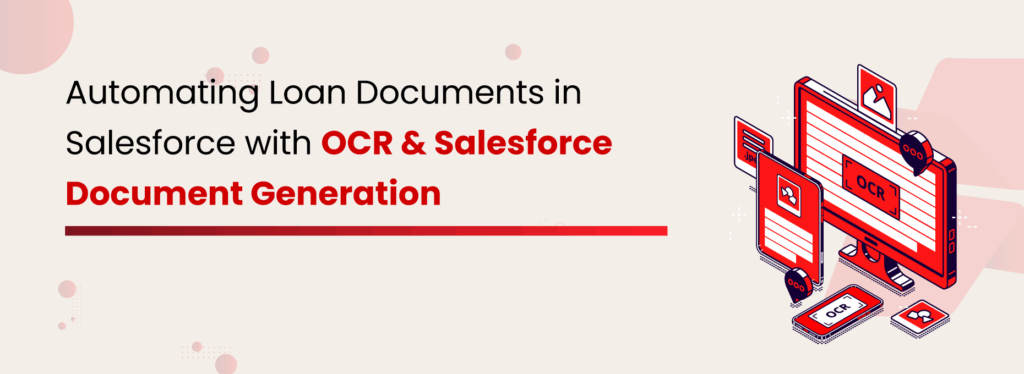
In today’s booming world, everything seems to come with a price tag. For this reason, many individuals turn to loans to fund their dreams, be it buying a home, expanding a business, or covering major expenses. For financial institutions using Salesforce, processing loans, especially at scale, requires handling large volumes of policy data, compliance documentation, and complex verification workflows. That’s where document automation tools come in, like an insurance policy for your Salesforce. They protect your workflow from delays, reduce manual effort, and streamline everything from loan data handling to compliance docs. Why Insurers Use Salesforce for Loan Process Management Most insurance companies are moving away from legacy administration systems and adopting Salesforce to manage customer data more efficiently. With its customizable platform and suite of Clouds, Salesforce can be tailored to handle every aspect of policy administration, from quote management and underwriting to policy servicing. It offers a single source of truth for all customer and loan information, eliminating the need for scattered systems and improving operational efficiency. The Manual Process Behind Loan Processing Traditional methods of managing a loan rely heavily on paperwork, siloed systems, and manual coordination between teams. From verification to loan approval and servicing, the lack of automation often results in inefficiencies, longer turnaround times, and poor customer experiences. It’s a process ripe for digital transformation. Before diving into automation, it’s important to understand the current steps involved in managing a loan process—and why they need a digital upgrade. Loan Eligibility Check Before starting the loan process, the agent verifies if the applicant is eligible. This involves retrieving the borrower’s/applicant’s profile in Salesforce and reviewing the KYC details, like income, credit score, government-issued IDs (SSN), or existing liabilities. Since this data isn’t always integrated, agents jump between Salesforce, spreadsheets, or admin portals to confirm eligibility. Eligibility Calculation The potential loan amount is calculated based on predefined criteria like income-to-loan ratio or creditworthiness. Agents manually enter data into custom Salesforce fields and use offline tools (like Excel) to run calculations. There are no built-in validations or rule-based suggestions in Salesforce, leading to inefficiencies and manual errors. Document Collection Applicants must submit documents like ID proof, address proof, income statements, and bank statements. Agents email or call applicants with the checklist. Documents arrive in inconsistent formats—photos, PDFs, scans—which agents must manually download, rename, convert, and compile. The result is a time-consuming, unstructured workflow. Loan Application Preparation Once documents are gathered, agents fill out loan application forms manually or via editable PDFs. Supporting files are individually attached or printed and compiled into a single application package. If any information is missing, the agent has to start over—adding more delays. Approval Workflow The loan file is routed to internal teams like credit, risk, and compliance for review. This handoff typically happens through emails or uploads to shared folders. Each reviewer may send manual feedback or request updates, and there’s no real-time system to track loan status. Agents rely heavily on follow-ups. Financial File Management, Redefined: Efficiency, Security & Collaboration in One Solution Download the Case Study! Compliance Check Each application must adhere to regulatory and internal compliance requirements. Agents refer to offline checklists to verify fields and documents, manually flagging issues like expired IDs or missing signatures. A single error can delay the entire process. Disbursement Once approved, the loan must be disbursed. Agents coordinate with finance teams via emails or phone calls, submitting disbursement instructions along with documents. It may take days to confirm transfer, and the agent must inform the applicant manually when the funds are released. Record Maintenance All loan details, documents, and notes must be logged into Salesforce or internal systems. This is usually double data entry—once in a form, then again in the CRM. Agents must also upload documents, tag them properly, and ensure the loan record is accessible for audits and customer service in the future. The entire manual process involves extensive data entry, downloading and re-uploading documents, cross-verifying information, and constantly switching between systems. That’s why automating these tasks is crucial, but how can you do that within Salesforce? The answer: XfilesPro DocGen and Document Management in Salesforce for Insurance Loan Automation Powerful & Efficient Automated Salesforce Document Generation Get the Datasheet! XfilesPro DocGen: Loan Automation in Salesforce XfilesPro is a trusted Salesforce document generation and management solution designed to make life easier for Salesforce users. With over 15 years of industry experience, we’ve helped more than 1,000 customers streamline their document processes. What’s our secret? A powerful combination of reliability, flexibility, and seamless integration that consistently delivers results. A Leading Swiss Insurance Provider Transformed Their Insurance Process with XfilesPro Get the Full Case Study XfilesPro offers three powerful solutions An OCR-powered tool (Xtract) A document generation application (DocGen) A platform for storage and collaboration Let’s see how these can help simplify Salesforce loan processing. Extract Document Details Within Salesforce Xtract is an AI-powered OCR solution that scans forms, handwritten notes, and images into structured Salesforce data, making it perfect for managing loan requests tied to insurance policies. Turn Scanned Documents Into Smart, Searchable Data Inside Salesforce Download the Datasheet! For instance, during the loan application process, an agent can simply upload a scanned copy of the customer’s insurance policy using Xtract. The OCR-powered tool reads the document, pulls out key data like policy number and surrender value, and maps it directly to the relevant Salesforce fields. This eliminates the need for switching between platforms, minimizes errors, reduces manual entry, and speeds up the entire process. Automate Document Generation and Approval Workflow With XfilesPro DocGen, you can automate every step of the Loan process directly within Salesforce, reducing delays, eliminating manual errors, and ensuring full compliance. Template Management Build and reuse templates for key documents like loan applications, policy eligibility reports, consent forms, and disbursement letters to maintain consistency and accuracy across all records. Dynamic Data Mapping Automatically populate documents with real-time Salesforce data, like customer details, surrender value, loan amount, and tenure, eliminating manual entry and reducing errors. Review &
Optimize Your Salesforce Purchase Order Process in Four Steps
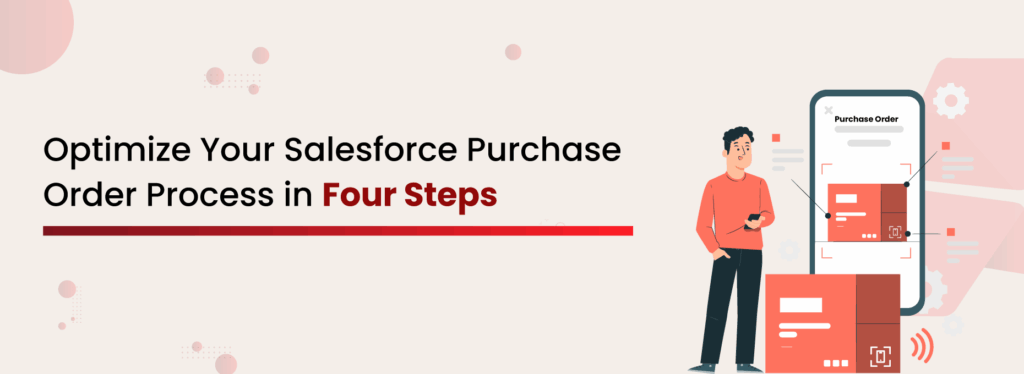
The Purchase Order (PO) process is essential for every business, whether it’s a simple stationery purchase or a large-scale heavy equipment requirement. No matter the size of the procurement need, the process ensures accountability, transparency, and traceability. However, many companies still rely on disjointed systems: Salesforce for customer data, third-party apps for document generation, and external cloud storage for files. This fragmented approach forces procurement teams to manage and track POs across platforms manually. And this isn’t just an inconvenience, it’s a risk. Manual processes open the door to errors, lost documents, delayed approvals, compliance issues, and even payment disputes. One missed document or outdated version could mean stalled deliveries, strained vendor relationships, or financial discrepancies. In short, a broken PO process can break your entire business flow. Now, what if we told you XfilesPro can change that? We can automate your PO process. Trust us when we say that it isn’t just any other tool. But before we show you how we’re different, let’s quickly walk through something every business deals with: Understanding the Purchase Order Lifecycle in Salesforce To truly optimize purchase order management, you need to understand its full lifecycle. Here’s how a typical PO flows through Salesforce: A Purchase Request (PR) is raised to initiate the procurement of goods or services. The PR goes through an internal approval workflow involving department heads. Quotations are collected from multiple vendors for comparison and selection. A Purchase Order (PO) is generated based on the approved PR and the chosen vendor. The PO is sent to the selected vendor, who then confirms and ships the requested items. Goods are received and inspected, and the delivery is matched against the original PO. An invoice is received from the vendor and processed for payment. All associated documents are stored securely for future reference, compliance, and audits. While the process may seem straightforward, many organizations struggle to manage it efficiently due to disconnected systems, manual workflows, and limited visibility. Why Manual Handling of the Salesforce Purchase Order Process is a Hassle At a glance, the PO process might look structured, but behind the curtain, it’s often far from it. Without a unified system, each stage becomes its own mini-project. Requests are logged in Salesforce, but approvals bounce around in email threads, causing delays. The PO is generated in another system and emailed manually, with no link back to the record. Goods arrive, but the team struggles to match deliveries with the right PO because versions are stored across multiple folders. The finance team loses time locating the right invoice or verifying approval history. During audits, the documentation trail is incomplete or inconsistent. Salesforce and the XfilesPro DocGen tool are a dream team; together, they fix the broken PO process by turning scattered tasks into a seamless, automated workflow. How can XfilesPro DocGen help with the Salesforce Purchase Order Process? Our Document Generation isn’t just another tool. It goes beyond the basic “click and generate” functionality. XfilesPro DocGen is built to simplify, streamline, and strengthen your Salesforce document generation process. Here is how the tool helps in automating the Salesforce purchase order. Powerful & Efficient Automated Salesforce Document Generation Get the Datasheet! Template Setup Made Simple We offer a wide range of pre-built templates, tailored by industry and department. When it comes to the Purchase Order process, you can easily raise a Purchase Request document using one of our ready-to-use templates. No need to design anything from the ground up. Just select the template that fits your needs, make a few quick edits, and you’re good to go. Automated Data Population XfilesPro pulls real-time data from Salesforce records, so your Purchase Requests and POs are always accurate and up to date. Just select the materials or services you need, and the relevant details populate instantly, saving time and reducing errors. Integrated Review, Approval & E-sign Workflow Once your document is drafted, even if you’ve customized the design to match your brand or internal formatting, it’s ready for internal review, approval, and even in-built Salesforce Signature, all within Salesforce. Whether it’s a department head or the finance team, everyone involved can review, comment, approve, and sign the document in a single, unified flow. No external emails. No confusion. Just a clean, collaborative process with total visibility. Link Documents to the Right Salesforce Record After your document is approved, XfilesPro ensures it’s stored exactly where it should be. Delivery receipts, invoices, vendor confirmations, everything is automatically saved and linked to the correct Salesforce record. No manual uploads. No lost files. Just organized, audit-ready documentation. Get DocGen from AppExchange! Okay, cool—now your documents are saved to Salesforce records. But here’s the catch:They’re still eating up your Salesforce storage. They’re scattered. You’re still sending emails from Salesforce to multiple vendors for quotes or updates. And suddenly, you’re juggling email threads, switching tabs, and losing track of who said what. Yeah… not ideal. Salesforce Document Management, Upgraded With XfilesPro, all your documents, whether it’s a Purchase request, a PO, or a vendor quote, are stored in external cloud storage (like SharePoint, OneDrive, Google Drive, or AWS), not Salesforce. That means zero storage bloat, better organization, and real-time access from the record itself. How do we do it? Zero Storage Bloat With XfilesPro, you can set up automated triggers to move your files from Salesforce to your external cloud storage of choice. These triggers can be based on specific conditions, like when an Opportunity is marked as Closed Won, a Purchase Request (custom object) is approved, a Purchase Order (custom or managed package) is sent, or a Vendor Quote is finalized. Better Organisation You can set a specific folder path, like Procurement → Purchase Requests → 2025 → File A. Whenever a document is added to a record, such as a Purchase Request, it’s automatically saved in the right location. This folder structure, defined by Salesforce fields, is mirrored in your external storage as well. Automating Folder Structure and Document Organization for Financial Enterprise Using XfilesPro Download the Case
Salesforce for Manufacturing: Boost Efficiency with Document Generation, OCR & File Storage
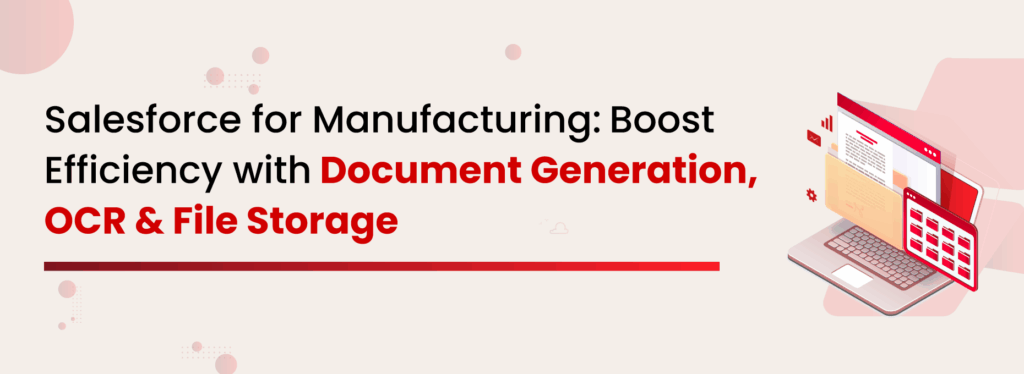
In the manufacturing industry, managing documents goes beyond merely keeping things organized. It is essential for maintaining compliance, preventing delays, and ensuring that products arrive at the right location at the right time. From purchase orders to quality checks, each step in the process must be executed with precision to ensure this success. But the harsh truth is that most teams are drowning in multiple documents, manual approvals, missed emails, and disorganized file & folders, hindering their efficiency and productivity. So, how can manufacturing companies break free from document overload and build a system that truly works? The Answer: Leveraging Salesforce with Smart Document Management Solutions Why? Because Salesforce is transforming the way manufacturers operate. With Salesforce Manufacturing Cloud, you can do more than manage customer relationships. By connecting sales, operations, and partners on a single platform, you gain better visibility, smarter forecasts, and control over every step. But even with all that power, there’s one thing that still clogs the gears: the document-heavy manufacturing process itself. Think about it, Purchase Order Management, Production & Quality Control, and Inventory Management, they’re all document-heavy, approval-driven, and deadline-sensitive. If you’re still stuck in manual mode, it doesn’t matter how powerful your CRM is, you’re always prone to errors, delays, and inefficiencies. That’s where document automation and external document management systems come in. When these integrate seamlessly with Salesforce, everything clicks into place. That’s when you stop wasting time on manual file management and start speeding up processes across the board. In this blog, we’ll break down exactly how all of this fits into your manufacturing process—from purchase orders to quality control—and why automating documents is the next step in building a more efficient, scalable operation. Purchase Order Management Picture this. Your purchase team urgently needs to source materials for an upcoming manufacturing unit. They’ve found a few solid vendors, and it’s time to request quotes, negotiate pricing, and raise a purchase order. Sounds straightforward? Not really. Here’s how it usually plays out: You raise a purchase request, which goes to the Department Head for approval and then to the Procurement Head. Once it’s green-lit, the RFQs go out, vendor quotes trickle in, and after some evaluation, you generate the Purchase Order(PO). The vendor confirms, shares invoices, and sets delivery timelines. But now you’re juggling Work Orders, Bill of Materials(BOMs), Vendor Quotations, Inspection Reports, NCRs, and of course, contracts. Production & Quality Control Once the PO is confirmed and the materials start arriving, it’s time to get into the thick of production. This is where your operations team kicks into high gear, and where the paperwork continues to pile up. From production schedules to inspection logs, everything needs to be tracked, verified, and approved Here’s what the usual flow looks like: Materials are received and logged Work Orders are issued Production begins Quality checks kick in at different stages NCRs and inspection reports are generated Final product is approved or sent back for rework You’re now managing Material Inspection Reports, WIP Checklists, QA Forms, NCRs, Compliance Certificates, and final QA sign-offs. Inventory Management With production rolling and quality checks in motion, it’s now up to inventory management to keep everything balanced. Raw materials in, finished goods out, and somewhere in between—real-time stock visibility is everything. Sounds easy in theory, but in practice? Things can get chaotic fast. Here’s how the typical flow goes: Goods are received and logged Inventory levels are updated manually Items are moved to production or storage Finished goods are recorded Dispatch and delivery details are entered Stock reports are generated for finance and procurement teams. You’re now working with GRNs, Stock Transfer Forms, Inventory Count Sheets, Dispatch Notes, and Delivery Challans. But even if you’ve managed to stay on top of these documents so far, it only takes one slip to disrupt the entire chain. Here’s Why Manual Handling of Operational Documents Holds You Back Let me ask you, if a document goes missing, how quickly can your team recover, and at what cost? And when documents are generated manually, how confident are you that every field is filled, every signature captured, and every version tracked? If you don’t know the answer, or if your answer starts with “it depends,” that’s already a cause for concern. Manual processes might’ve worked back when operations were simpler. But today? With everything moving fast and expectations even faster, managing documents by hand is like trying to race a jet with a bicycle. If you manage your Purchase Orders, Vendor Quotes, and Work Orders manually, you already know the pain. One missed email, one outdated version of a BOM (Bill of Materials), or a missed detail in the Inspection Report can suddenly throw your whole workflow off balance. You’ve probably seen it firsthand: That NCR (Non-Conformance Report) form that went missing just before a final quality audit The GRN (Goods Receipt Note) that didn’t make it to the inventory team in time The Dispatch Note that was saved in the wrong folder, delaying shipment The QA Certificate that never got signed off, holding up production There is a risk of missing details when documents are created manually. This issue becomes more pronounced when there is no automated workflow for review and approval. As a result, you may be losing valuable production hours. Many manufacturers assume that implementing multiple software solutions will be expensive and technically overwhelming, but that’s not the case. Did you know document-related issues can cause up to 21.3% productivity loss? A Heavy Equipment Manufacturing Industry, known for powering infrastructure with high-performance machinery like cranes and excavators, struggled with scattered files, poor folder sync, and unclear access controls. That’s when XfilesPro stepped in. By streamlining document storage, syncing, and access management, they increased efficiency, saved time, and ultimately boosted overall productivity. Download the case study to know more Meet XfilesPro: The Automated Document Management Suite You Need XfilesPro is purpose-built for managing documents within Salesforce. It aligns seamlessly with your industry’s compliance and operational needs. Let me walk you through
20 Ways XfilesPro Helps You Slash Operational Costs in Salesforce
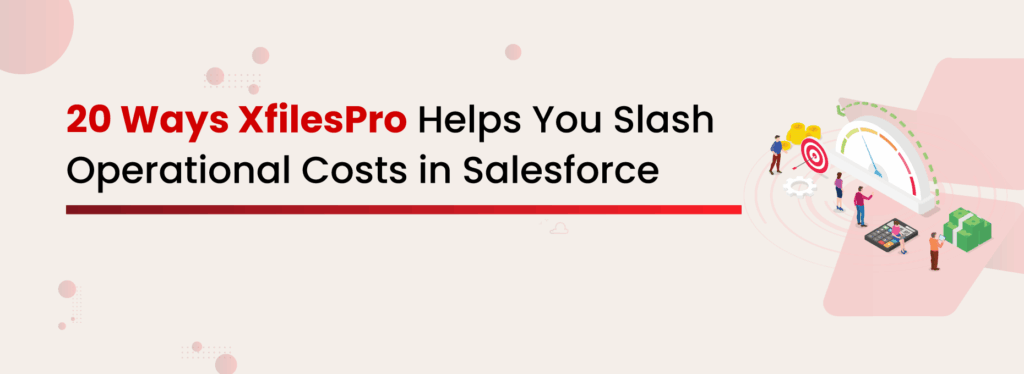
Salesforce file management has its limitations that every Salesforce admin is aware of. While many users highlight limited storage space as the primary issue, the real challenge goes beyond that. It’s not just about how much you can store; it’s also about how effectively you can manage it. This includes aspects like improved collaboration, seamless document access, enhanced security, and easy search and sharing. Unfortunately, Salesforce as a CRM does not provide these features. That’s why businesses move their files to external storage like SharePoint, Google Drive, OneDrive, or Amazon S3. These platforms offer end-to-end file management solutions that are not possible within Salesforce But you can’t just magically transfer files. Doing it manually means downloading everything from Salesforce, uploading it again to external storage, and wasting hours, only to end the day feeling completely burnt out. File management tools like XfilesPro help companies declutter, automate processes, and significantly reduce costs—all without compromising on performance, security, or compliance. So, How Does XfilesPro Help You Slash Operational Cost? XfilesPro doesn’t just save on Salesforce file storage. It cuts down manual work with automation, reduces IT overhead with easy-to-manage file integrations, and helps avoid compliance slip-ups with secure, traceable file movement. That’s less time spent, fewer tools needed, and way more value out of your Salesforce investment. Let’s break it down: Cut Direct Storage & Licensing Costs Reduced Salesforce Storage Costs by 80%+ Salesforce charges up to $5/GB/month, and Amazon S3 at just $0.023/GB/month. By using XfilesPro to offload files to more cost-efficient cloud storage solutions like Amazon S3 or SharePoint, businesses can reduce their Salesforce file storage cost by up to 80%, saving thousands annually. Eliminate Manual File Transfers Transferring 1,000 files manually can take days. The process of downloading, uploading, and organizing each file consumes a significant amount of time. XfilesPro automates this entire process, reducing manual work and saving your team hours every week. Additionally, manual transfers are prone to errors, which increases the chances of missing some files or experiencing transfer failures Bulk Migration of Historical Files XfilesPro lets businesses bulk migrate large volumes of legacy files from Salesforce to external storage in one seamless transfer. This saves on storage costs and eliminates the manual effort of cleaning up data. Use Existing Subscriptions Smartly If your business has already subscribed to Microsoft 365, Google Workspace, or Amazon Web Services, XfilesPro integrates seamlessly with these platforms to make full use of their storage capabilities. This way, businesses don’t need to purchase additional storage or tools, maximizing existing investments. Secure File Sharing Without Licenses Sharing files with third parties or external collaborators typically requires extra Salesforce licenses. With XfilesPro, you can share files directly from external storage or Salesforce, eliminating the need for additional licenses. Automate Workflows and Save Time Organize with Smart Folder Structures XfilesPro allows automatic folder creation based on predefined rules like record types, departments, or case types. This level of automation eliminates the time-consuming process of manually organizing documents, reducing administrative costs, and keeping your storage system tidy. No-Code Customizations XfilesPro lets you set up file movement, organization, and syncing through a no-code configuration. This removes the need for dedicated development resources, lowering IT costs and giving teams the flexibility to adapt the tool as needed. Automated Workflows Based on File Events XfilesPro allows you to create triggers and automated workflows based on file movements. For example, when a contract is uploaded to Salesforce, XfilesPro can automatically move it to a “Contracts” folder in external storage and tag the file. A trigger can also be implemented to create subfolders when a record is added. This automation reduces the need for manual oversight, accelerates decision-making, and lowers operational costs. Read More: 8 Ways XfilesPro Automates File Management Process in Salesforce Drag-and-Drop Simplicity Uploading, moving, or managing files becomes as easy as drag-and-drop. This reduces the learning curve and eliminates training costs, allowing even non-technical users to quickly manage their files without IT support. Faster Onboarding for New Users Since XfilesPro integrates directly with widely used platforms like Google Drive and SharePoint, new employees can quickly get up to speed with the document management system without needing extensive training. This reduces onboarding costs and accelerates time-to-productivity. Boost Team Efficiency Across Departments Access Files from Inside Salesforce Even after documents are moved to external storage, XfilesPro makes it possible for Salesforce users to access and manage them directly within Salesforce. This eliminates the need for switching platforms or logging in to multiple tools, saving time and reducing operational friction for employees. Remote & Mobile-Friendly Access External cloud storage like Google Drive, OneDrive, and SharePoint offers mobile access, allowing field teams or remote workers to upload and access documents anytime, from anywhere. This flexibility enhances efficiency and reduces travel-related costs for teams that previously needed to be on-site. External File Collection Made Simple XfilesPro enables you to collect files from customers, vendors, or partners through secure, one-click email upload links, no Salesforce login required. This simplifies collaboration, reduces back-and-forth emails, and eliminates the need for costly third-party file collection tools. Boost Cross-Functional Collaboration With all teams working in the same centralized storage, communication becomes smoother, and collaboration is streamlined. This reduces the need for multiple communication tools and prevents unnecessary back-and-forth between teams, ultimately saving time and reducing inefficiency. Community Portal File Storage For businesses with customer or partner portals(Community Portal), XfilesPro ensures that any files uploaded through these channels are stored directly in external storage. This reduces Salesforce storage consumption, enhances security, and minimizes costs by reducing the need for additional storage capacity. Field Service-Friendly Field agents use the Salesforce FSL app to capture images, reports, and invoices. With XfilesPro, these files can be transferred directly to SharePoint from the field. This eliminates the need for agents to manually send files via email or upload them later, cutting down on administrative overhead and ensuring instant documentation. No Need for Additional Document Management Tools External platforms like SharePoint or Google Drive can serve as your document management system (DMS),
How is XfilesPro Redefining Document Security in Salesforce?
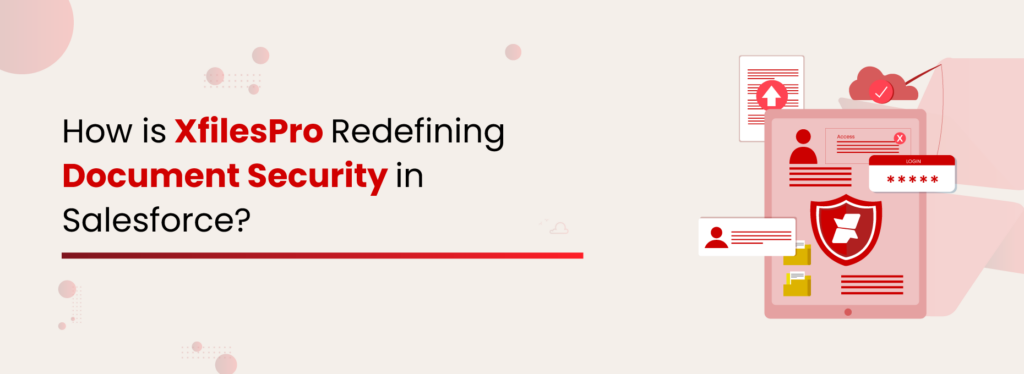
As businesses embrace digitalization, manual document management has significantly reduced—but this shift has brought new challenges, particularly in the security landscape. Enterprises rely on software services to streamline operations. Salesforce is one of the most preferred CRM platforms. But while everyone talks about Salesforce data breaches, it’s crucial to recognize that unauthorized access to documents can also lead to serious compliance risks. Security isn’t just a checkbox; it’s a necessity. At XfilesPro, we prioritize safeguarding your documents. But before we dive into how we do that, let’s explore why Salesforce document security is essential for your business. Document Security in Salesforce Document security ensures files are safeguarded against unauthorized access and potential breaches. With increasing cybersecurity threats, implementing strict access controls, audit logs, encryption, and compliance management is essential to safeguarding business-critical documents. Organizations must go beyond basic storage and ensure that document access is restricted based on roles, activity is monitored, and file-sharing is controlled. On-Demand Webinar 5 XfilesPro Features to Boost Document Security & Collaboration in Salesforce Watch the free Webinar! Why Document Security in Salesforce Matters Salesforce is generally safe to use, while it provides extensive security measures for data, documents stored within the platform often remain vulnerable. A breach of sensitive documents can have consequences just as severe as a data breach. This can lead to various risks as follows Unauthorized Access to Sensitive Information Not all Salesforce users within an organization require access to every document. Without proper security controls, confidential files may be accessible to unintended users, leading to data leaks and privacy concerns. Suppose sensitive information falls into the wrong hands. In that case, it can be misused—resulting in threats, data theft, or manipulation of critical records such as customer data, financial information, intellectual property, and trade secrets. Compliance Risks in Regulated Industries Industries like finance, healthcare, and legal services operate under strict compliance regulations. Laws such as GDPR, HIPAA, and SOX mandate secure document storage and controlled access, ensuring only authorized individuals can view sensitive information. Failure to comply can lead to hefty fines, legal consequences, and reputational damage. Lack of a Centralized Document Security System Businesses often store Salesforce documents across multiple locations—Salesforce Files, third-party storage platforms, local drives, and cloud services. Without a unified security strategy, tracking document access and maintaining consistent protection across all storage points becomes a challenge, increasing the risk of security gaps. Audit Issues Enterprises need to keep a clear record of who accessed, modified, or shared documents to meet compliance requirements and internal audits. Without a proper audit system, tracking document history becomes challenging, making it harder to spot unauthorized changes, ensure accountability, and avoid compliance risks. Take a financial organization, for example. They handle countless customer documents containing sensitive information. If these documents are not properly secured, they could be exposed to unauthorized users, leading to compliance violations, financial losses, and reputational damage. XfilesPro: Redefining Document Security in Salesforce With businesses managing more and more documents in Salesforce, keeping them secure and accessible isn’t always easy. Security, compliance, and storage limits make it crucial to have a smarter solution. That’s where XfilesPro comes in. But what exactly does XfilesPro do? XfilesPro The One-Stop Solution for Advanced Document Management in Salesforce Download the Datasheet! XfilesPro is a document management and collaboration application built specifically for Salesforce. It seamlessly integrates with external cloud storage solutions like Google Drive, SharePoint, OneDrive, and AWS S3. By reducing the need for additional Salesforce storage, XfilesPro helps cut costs while automating file migration to boost productivity. At the same time, it ensures your documents remain safe and secure. Let’s dive into how XfilesPro protects your documents. Role-Based Access Control In any business, controlling who can access, edit, or share documents is crucial, with XfilesPro access and permissions based on their role in Salesforce. Permissions can be assigned during template creation and secured at different levels: by Profile, Public Group, individual users, or open access, giving complete control over document security. For businesses using SharePoint, users can be restricted access to a particular site and not all sites. This is also true with Amazon multi-buckets. Secure Sharing For businesses, it’s important to collaborate on documents both internally and externally. However, accidentally sharing a document with the wrong person can lead to serious issues. To prevent this, XfilesPro offers secure sharing features, allowing you to send documents via email with password protection. An expiration date and time can also be set, ensuring the file becomes inaccessible after the specified period. Encryption & Secure File Transfers Documents are vulnerable to breaches, leaks, and unauthorized access without proper encryption and secure file transfers. Security isn’t just about who can access files—it’s also about how they’re stored and shared. XfilesPro encrypts documents both at rest and in transit, follows global security standards, and ensures that encryption keys stay protected during every transaction. Effortless Reauthentication Businesses relying on SharePoint, Google Drive, or AWS S3 for document storage via Salesforce often face authentication token expiry, which blocks access to critical files. This disrupts workflows, delays tasks, and requires IT intervention to restore connections. To solve this, XfilesPro offers a Reauthenticate button. With a single click, it refreshes authentication, prevents downtime, ensures seamless access, and keeps operations running smoothly—without security risks or IT hassles. Real-Time Document Tracking & Audit Logs Businesses struggle to track document activities, leading to unauthorized modifications, security risks, and compliance issues. Without proper monitoring, files can be edited or shared without oversight, compromising data integrity. By utilizing real-time tracking and logging, businesses can monitor who accesses, edits, or shares information. With version history and a comprehensive audit trail, organizations can ensure security, prevent unauthorized changes, and maintain compliance with ease. Document Deletion Without proper deletion mechanisms, removing a Salesforce record can leave orphaned files and folders in external storage. This gap risks compliance retention and sensitive data exposure. XfilesPro automatically deletes all associated external files and folders when a record is removed, ensuring complete document removal. This upholds compliance retention standards. Compliance-First Document
Organize to Optimize Your Salesforce Documents With XfilesPro
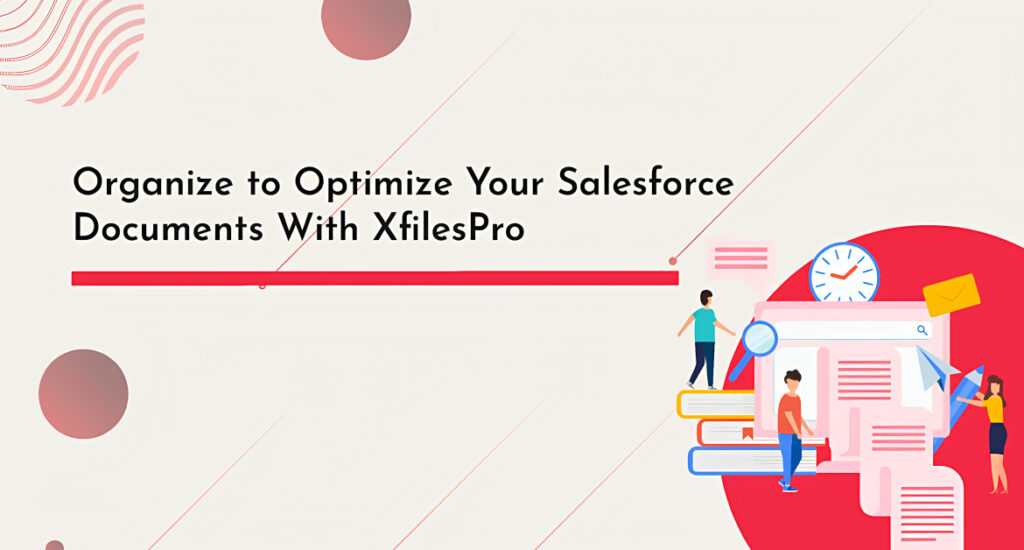
Managing files in Salesforce can feel like an uphill battle, scrolling through alerts, stressing over storage limits, trying to make sense of Salesforce’s file storage costs and confusing questions can leave anyone feeling frazzled. If you’re feeling that pressure right now, trust me, you’re not alone. Many companies hit that same wall. The good news is, there are smart ways to handle Salesforce storage that can totally change the game. With the right approach, you can take control of your documents and put those headaches behind you. Why Is Salesforce File Storage So Tricky? Before we dive into how to manage it, let’s talk about why managing a large volume of files within Salesforce can be so frustrating. Salesforce isn’t designed as a file storage system; its primary focus is on customer relationship management (CRM) and streamlining business processes. This means it lacks some features dedicated to large storage solutions, leading to challenges for users who expect those capabilities. Once you exceed Salesforce’s file storage limits, you’ll hit with additional storage costs, which can add up quickly. According to a recent report 361.6 billion emails are sent worldwide every day, these emails are expected to contain attachments such as PDFs, images, and more. Businesses that utilize Salesforce often have these attachments stored in Salesforce’s primary file storage for varied reasons. This combined with the different types of files (Documents, Images, videos etc) uploaded through web portals or generated from third-party applications can become tricky to handle without a proper structure. Although Salesforce has Files Connect to connect external platforms for file migration, it has a few limitations. Accessibility is one of the biggest challenges, with limited search capabilities making it difficult to locate documents efficiently. Users are often restricted to basic search functions, causing frustration, especially in larger organizations dealing with massive volumes of documents. In a collaborative environment where multiple users might update the same documents simultaneously, version conflicts, outdated edits, and change tracking of who did what and when add another layer of complexity. Collaboration sometimes means giving external access, but with the limited features of the Salesforce solution, this can get complicated. Without proper permission controls, the risk of unauthorized access and confusion over who can do what increases. Wondering If Your Business Needs a Document Management Solution? Read to Learn More. XfilesPro’s Path to Better Document Management: From Organize to Optimize XfilesPro is a robust Salesforce file management solution designed to seamlessly integrate Salesforce and your preferred external storage (SharePoint, AWS S3, Google Drive, OneDrive) facilitating document migration. XfilesPro is like a digital personal assistant you thought you never needed. It starts by giving you the freedom to organize your files in a way that works best for you. Whether you prefer the simplicity of Default folders or the tailored approach of Custom folders, XfilesPro adapts to your needs. Within these folders, you can create subfolders, and the automation of templates allows you to store documents in designated subfolders automatically. XfilesPro makes sure your files are organized in their designated folders, but when you’re managing tons of documents, finding what you need can feel overwhelming. That’s where Tagging steps in! With Manual, Auto, or Custom tagging, you can easily label each file, making it simple to find what you need. Documents are a key part of any business, and keeping sensitive information safe from unauthorized access is really important. That’s why securing these documents is so crucial. With XfilesPro Folder/File Preserve, your important documents are protected from accidental loss. To keep your documents safe, the user access control feature allows you to give specific access levels to the right people, safeguarding data, and preventing unauthorized access. This means documents can be effortlessly shared within teams and with external users, while you maintain control over their access, whether it’s to preview or view files within Salesforce, or to have direct access to external cloud storage. The XfilesPro Bi-sync feature keeps files and folders synced across both platforms. When users make changes to a document, these updates are automatically reflected in both Salesforce and the connected external cloud storage, ensuring everything stays up-to-date regardless of where the changes are made. So, how does this organization actually optimize your Salesforce usage? It’s simple. By moving files to external storage you can save on storage costs, with XfilesPro integration you don’t have to pay for the space you don’t need. More storage efficiency, more savings. Additionally, this file migration enhances platform performance by reducing load times when accessing or processing documents. All your files will finally be in one place, giving you a single, organized hub where you can easily view them. Whether they come from AppExchange apps, Field Service Lightning app, Experience Cloud, or elsewhere, everything is organized and easy to access. This means less time searching and more time to get things done. Real-time synchronization across both platforms maintains different document versions. It ensures that users with access to the documents are working on the updated version, and fosters better collaboration between team members. This increases efficiency and leads to better and faster decision-making. This is just a glimpse of what XfilesPro can do. Beyond seamless file migration, user access control, folder/file syncing, and storing files in a structured way, XfilesPro can do more. XfilesPro has been in the industry for over a decade and has taken document management to new heights across a wide range of sectors. By integrating XfilesPro with Salesforce, organizations have experienced significant ROI, saved time, and improved user experiences. Book a demo with our experts today to explore the full potential of XfilesPro. Poornima GConnecting businesses with top SaaS and CRM solutions through engaging content All Posts
Why is XfilesPro the Top Choice for Salesforce Document Storage and Collaboration with SharePoint?
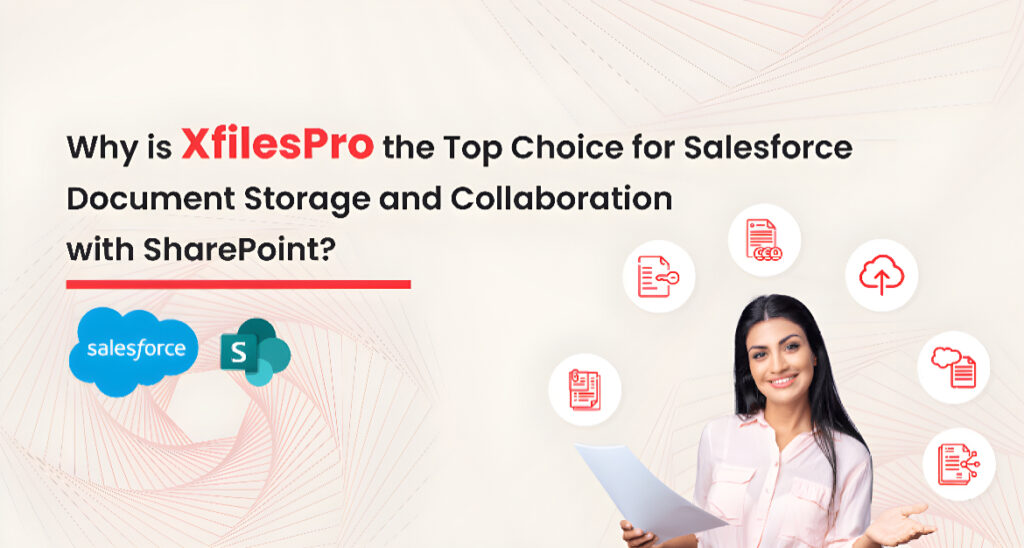
When it comes to business operations, Salesforce and SharePoint are a popular dynamic duo. Businesses unanimously agree that the power of this duo truly serves potential results that impact business success. While discussing Salesforce-SharePoint integration, for document storage and collaboration, one common solution that often comes up is XfilesPro. Have you ever wondered how XfilesPro became the most recommended solution for integrating these two giant platforms? This article details the nuances of leveling up document handling experience with XfilesPro by building a synergy between Salesforce and SharePoint. Before getting into its details, let’s discuss the significance of integrating Salesforce with SharePoint. Why is Salesforce-SharePoint Integration Required? While Salesforce has many functionalities for uploading and managing documents inside the CRM, it doesn’t come free from limitations. The users experience challenges with limited storage, high storage upgradation charges, folder structure creation, collaboration, accessibility, etc. We have to admit that Salesforce is a CRM, not a DMS. To address these hurdles before they impact productivity, companies adopt document-based collaboration systems like Microsoft SharePoint that streamline document dealing and collaborative experience. Because building a powerful bridge between Salesforce and SharePoint offers various benefits that can boost the efficiency and effectiveness of your business operations. Cost Savings Salesforce’s storage cost can be substantial. It can quickly add up as your business grows and accumulates files inside the Org. However, the integration with SharePoint unleashes the opportunity to leverage the extensive storage capacity of this system, resulting in high-cost savings. Easy Document Access Salesforce limits document access to every department to ensure security. However, this can cause operational challenges as cross-functional teams can’t access required documents. The Salesforce-SharePoint integration plays a critical role here as the wide and secure accessibility of SharePoint permits authorized users to access documents. Enhanced Collaboration The seamless integration between Salesforce and SharePoint allows teams to effortlessly share, access, and manage documents within the Salesforce environment by leveraging SharePoint’s powerful document management capabilities. This provides real-time updates and collaboration on shared documents, ensuring users access the latest information. The XfilesPro Way of Integration XfilesPro is the #1 document management app that establishes a strong and seamless integration between Salesforce and SharePoint. This connection takes place so easily that you can immediately embark on a new document management journey. Post integration, XfilesPro enables you to automate the migration of files from Salesforce to SharePoint (including your big-sized files) so that your Salesforce file storage space will remain optimized. Here, XfilesPro identifies SharePoint as a reliable and comprehensive external repository for migrated documents offering superior functionalities for a modern document management experience. Let’s look into how XfilesPro adds more value to your Salesforce-SharePoint integration endeavor. Quick and Seamless Integration XfilesPro adopts a highly streamlined process to establish the connection between your CRM app and the external storage. The best part is that this connection comes with zero coding requirements! Here, XfilesPro eliminates the complexities typically associated with integrating two cloud platforms, providing an intuitive interface that doesn’t require technical expertise. Since it’s a fast & hassle-free integration, the entire process gets done in a short time so you can experience advanced document management in minutes. Unlimited and Centralized Storage Once the large volume of documents is moved from Salesforce to SharePoint, the file storage space of the CRM app gets optimized and unburdened. Here, the document migration is not a one-time job, instead, it’s a recurring process that secures the storage space irrespective of the document growth. This in turn creates unlimited space in Salesforce and a centralized document management location in SharePoint. Having a centralized storage space, your authorized users can easily access documents, eliminate the search through multiple systems, and work on documents in real time. Robust Document Security Whether it’s NDA, proposals, quotes, or contracts, every document should be secured while using and when sharing it with other users. XfilesPro ensures the security and seamlessness of document sharing in both these scenarios with its advanced functionalities. When it comes to document sharing, our application offers an enhanced security model in which specific capabilities ensure document security while sharing it with internal teams as well as external parties. On the other hand, to safeguard the documents while using them, XfilesPro imposes Access Control, which permits only authorized users/teams to access specific documents. Similarly, users can also leverage XfilesPro’s Folder/File Preserve functionality that enables document deployment to a particular user/group/profile. Strong Compliance Adherence Different industries uphold different compliance standards. If your business belongs to any such industry that demands the retention of documents for several years (eg: healthcare, legal, finance, real estate, government), the limited file storage space of Salesforce will throw a spanner on this action. However, you can easily overcome this challenge with XfilesPro. As the application pushes your documents to SharePoint, you can stay worry-free about the small storage allocation by Salesforce and retain the documents for any number of years in SharePoint. Here, XfilesPro helps you strongly adhere to your compliance guidelines that insist on document preservation. SharePoint Tagging Support The greatest advantage XfilesPro unleashed to reinforce the Salesforce-SharePoint integration was its support for the Tagging feature. XfilesPro enables Tagging for Salesforce files in SharePoint, which is the assignment of categories or descriptive words to content, using labels. These tags serve as metadata that categorizes content based on various attributes such as topic, project, department, or any other relevant criteria, helping to easily filter and locate the files. Adding more value to the Tagging functionality, XfilesPro also supports Custom Tags and Auto Tags. In these, the former are the user-defined label attributes that can be applied to documents, items, or pages while the latter are automated metadata or label assignments applied to documents based on predefined rules. The highlight here is that you can provide unlimited Tags using XfilesPro. Field Service Lightning Support If your business belongs to an industry that demands field service agents, you must be leveraging Salesforce Field Service Lightning (FSL). It’s a system made by Salesforce to help companies that provide on-site services to better organize their work. As XfilesPro offers support to FSL, SharePoint
How Does XfilesPro Make Document Sharing Secure and Seamless in Salesforce?
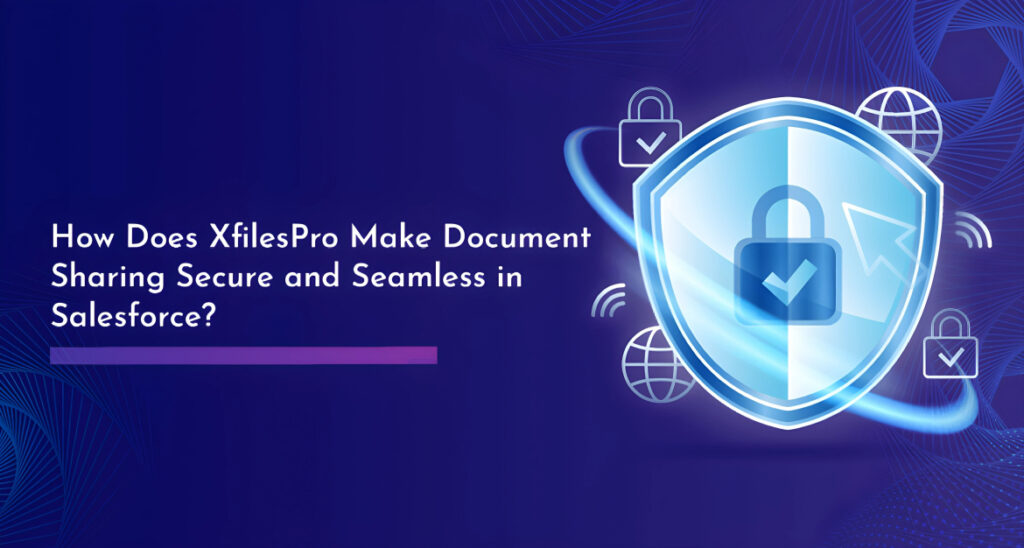
Every business is built on teamwork. And, the success of teamwork is defined by effective communication and collaboration among teammates. One of the key components of efficient collaboration is document sharing inside Salesforce. Whether it’s sharing reports, proposals, presentations, or other vital documents, the ability to seamlessly exchange information inside the CRM is crucial for boosting productivity and innovation. It’s the driving force behind achieving business goals. The most popular document management application for Salesforce, XfilesPro understands the significance of securely and effortlessly distributing documents within the Salesforce platform. So, XfilesPro offers many advancements to streamline this everyday process. The Enhanced Security Model for Document Exchange XfilesPro provides two distinct capabilities based on whom you share the document in order to facilitate the information exchange between multiple parties. Let’s look into each of those. Internal Document Sharing: Here is where you can share files, documents, and information within a team or organization. This type of sharing occurs among employees, departments, or project teams who work together within your company. The key purpose of internal document sharing is to effectively collaborate, communicate, share knowledge, and enable workflow management for your employees. To ensure security during this process, XfilesPro upholds certain standards. XfilesPro permits only authorized persons to share documents with other users, profiles, and groups. Here, Admins have complete control over deciding who can be entitled as authorized users and the authorized users can decide who can view, edit, and delete a file. This means that any unauthorized individuals do not share or access your Salesforce documents so you can rest assured about its security. External Document Sharing: This involves sharing documents and information with individuals or entities outside of your organization. To be specific, external document sharing occurs with external stakeholders such as leads, vendors, partners, customers, or suppliers. The key purpose of this way of document sharing is to enhance collaboration and communication with external parties, which is vital to the business’s success. To ensure security during external document sharing, XfilesPro has a specific criterion to meet. While sharing a document, the owner of the document needs to share a password-protected link via email to the external user. This link is one-time usable and has a certain validity time defined by the owner. Therefore, it is ensured that the document remains inaccessible to irrelevant users without the owner’s permission. In brief, XfilesPro ensures there is no security breach on a document while sharing internally or externally. Going Above and Beyond to Preserve Document Security XfilesPro’s commitment to security extends beyond document sharing. As you know, XfilesPro takes care of your complete document management in Salesforce. To not let your business suffer from the limited storage space of the CRM app, XfilesPro moves your files from Salesforce to any of your preferred external storage including SharePoint, AWS S3, Google Drive, and OneDrive. Here, most users are worried about document security post-migration to external storage. The good news is that XfilesPro has many more advanced capabilities that safeguard your documents in the outside repository. Here are two of them. Access Control: This is the fundamental component of document security which empowers Admins to provide user/profile level control on document creation, deletion, download, and upload. That means Admins can define which user/profile should obtain different kinds of document control in the external storage. Access Control plays a crucial role in safeguarding the confidentiality of the file and mitigating risks of breaches. Folder/File Preserve: You can leverage the benefits of Folder/File Preserve functionality by enabling the document deployment to a particular user/group/profile. This functionality ensures that only people who belong to any of these categories will be able to access a particular document. Here also, the owner can decide who needs to be added under any of these categories and what documents they can use. Again, security is guaranteed! In a nutshell, XfilesPro delivers superior functionalities to ensure document security in Salesforce. If your business wants to secure Salesforce documents with XfilesPro, please connect with one of our experts. Deeshna CDeeshna is a five-year experienced writer in the field of B2B, writing a wide range of content types that drive the success of SaaS products. All Posts www.xfilespro.com
How to Know if Your Business Needs a Document Management Solution for Salesforce? 5 Signs
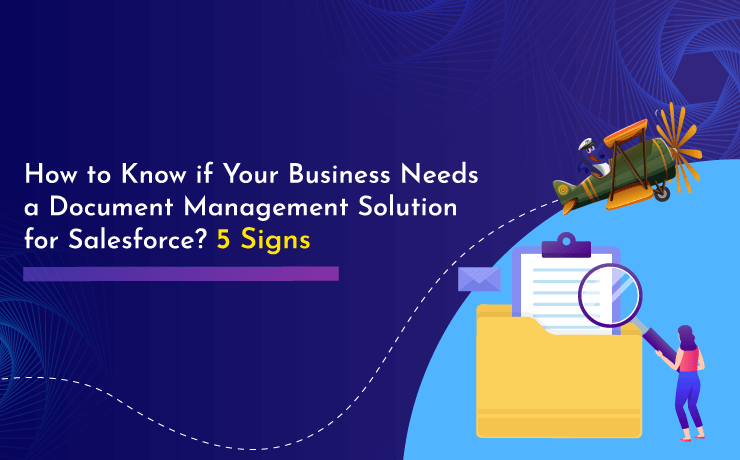
Are you aware that there are always some signs that indicate the need for a document management solution for Salesforce for you? If not, find those in this blog
How Strategic Document Management in Salesforce Saves Time & Cost?
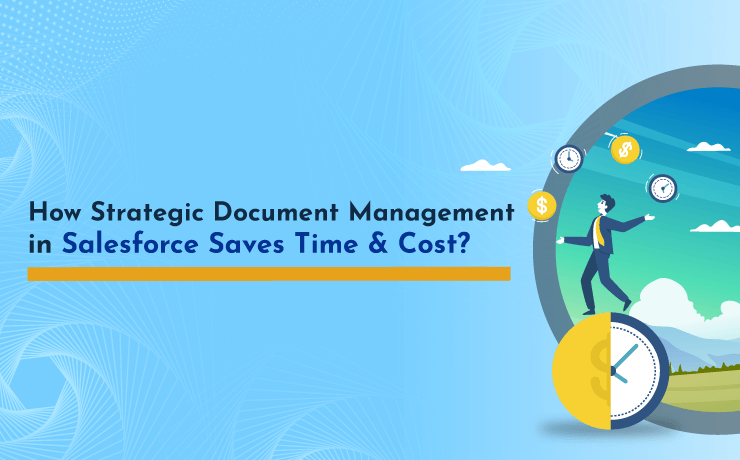
How much time does your team spend on creating, storing, accessing, and modifying documents inside Salesforce? Did you ever recognize the monetary loss that indirectly happens due to such an inefficient document management approach? Studies have widely shown that processes like document generation, navigation, and migration claim huge productive hours for employees.

